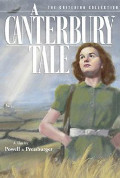
Directed by
Michael Powell / Emeric Pressburger.
124 minutes
Rated PG
Reviewed by
Bernard Hemingway

Canterbury Tale, A
Although it did not fare well on its initial release, A Canterbury Tale has since come to be regarded as a classic statement of English post-war neo-romanticism with its religion-imbued poeticising of the English landscape and the purity of nature . The film, of course, takes its title from The Canterbury Tales of Geoffrey Chaucer and updates it to wartime Kent. With a goodly proportion of the film given over to Anglo-American relationships it is classifiable as a war propaganda film but one which is a good deal more sophisticated than its contemporary peers including Powell's own 49th Parallel.The story concerns British Sergeant Peter Gibbs (Dennis Price), US Sergeant Bob Johnson (played by real-life non-professional actor Sergeant John Sweet), and a 'Land Girl', Miss Alison Smith (Sheila Sim). The group arrive at the railway station in the fictitious small Kentish town of Chillingbourne (a hybrid of the real Chilham and Sittingbourne) near Canterbury in August 1943. As they leave the station together Alison is attacked by an unknown assailant in uniform who pours glue on her hair, then flees into the night. The three combine forces to catch “the glue man” who turns out to be the local magistrate, Mr Thomas Colpepper (Eric Portman).
It is, to say the least, a fairly silly story but the childlike quality which pervades the film reflects a yearning pre-war bucolic innocence. This is realized with P & P’s characteristic mannered charm, notably in a scene in which Portman’s Colpepper give a lantern slide show about Kentish history to a group of servicemen whilst in an extended sequence a large group of children play at war games. The latter is filmed with cinematographer Erwin Hillier's black-and-white "Expressionist" stylings whilst a documentary realism is used for representation of the Kentish countryside, and in particular in the recording of bombed-out Canterbury itself, significant parts of the city centre having been flattened in German bombing raids of May/June 1942 (Canterbury Cathedral was not available for filming and was recreated within the studio by art director, Alfred Junge).
FYI: For the much-shorter (95m) postwar American release, Raymond Massey replaced Esmond Knight as narrator and Kim Hunter was added to the film as Sergeant Bob Johnson’s sweetheart.
Margaret Mitchell, the author of Gone With The Wind, was killed by a speeding car whilst walking to a screening of it in Atlanta, Georgia, USA in 1949.
Spike Milligan parodied the film in a 1954 Goon Show episode, The Phantom Head Shaver of Brighton whilst anyone who's seen 1998's There's Something About Mary, will have their suspicions about the nature of the "glue" confirmed.
Want something different?





